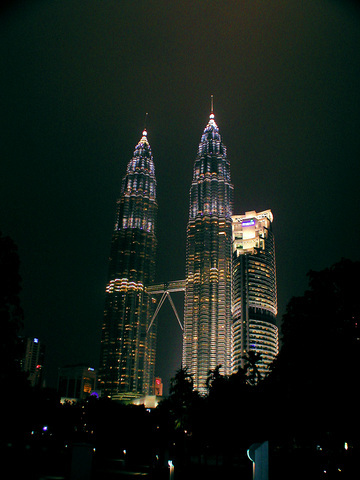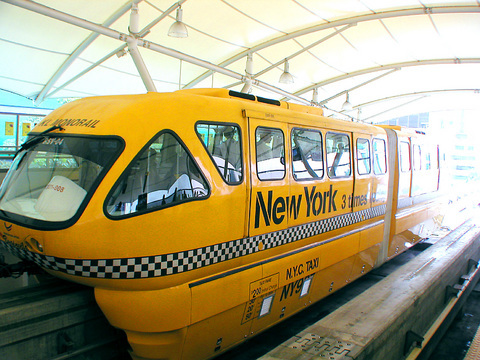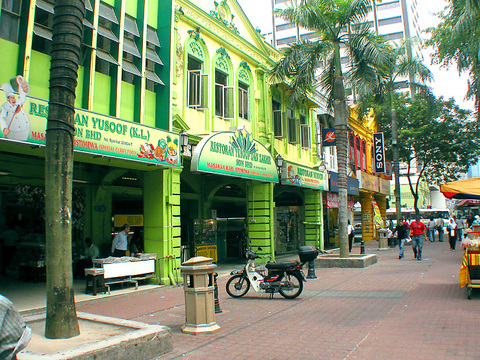Like many Southeast Asian metropolises, Kuala Lumpur is a city of contrasts and dazzling contradictions. Cookie-cutter commercial outlets stand beside repositories of rich cultural heritage, while the architecture of break-neck global capitalism -- exemplified by the Petronas Towers -- looms over ramshackle neighborhoods bursting at the seams with the buzz of local culture and life.
For the visitor passing briefly through Kuala Lumpur, the mix of Malay, Indian, Chinese, Thai and other cultures native to Malaysia can be extremely daunting to take in, much less understand in any comprehensive or coherent fashion.
But the following itinerary of major and minor sights in and around the city can give the harried traveler a glimpse into the country's colorful culture in the space of a single day.

PHOTO: TAIPEI TIMES
Batu Cave
On the northern outskirts of Kuala Lumpur is a major Hindu holy site named Batu Cave and located inside a limestone hill. A temple dedicated to the Hindu deity Subramaniam is located in the back of the cave, which is reached by climbing exactly 272 stairs to the grotto's mouth. Rascally monkeys can be seen on the staircase and inside the cave, where barriers have been installed to prevent them from throwing objects onto pilgrims below. The world's tallest Hindu religious sculpture is currently under construction at the base of hill.
Central Market

PHOTO: TAIPEI TIMES
Formerly the city's main covered market, Central Market has undergone major changes in recent decades and is now heavily frequented by tourists, which is reflected in the shops dedicated to selling items of interest mainly to this group. The building's colonial architecture, which has been thoughtfully preserved and extremely well maintained, is the highlight of the market, but the knick-knacks sold within make for perfect Malaysian gifts.
Petaling Street
Practically down the street from Central Market lies Petaling Street, the heart of the city's bustling Chinatown. It's here that Malaysians and tourists alike mingle to buy a dizzying array of knock-off goods, including faux Rolex watches, Gucci bags, Nike shoes and next week's Hollywood releases out already in this market on DVD. Police make rather desultory efforts to shoo away the more flagrant rule violators who set up in the middle of the street, and one amusing way to rest tired shopper's feet at the market is to sit at one of the many Chinese tea stalls and observe the cat-and-mouse game the vendors play with police.

KL-Tower
In the heart of town, not far from Petaling Street stands KL-Tower, a 421m-tall telecommunication tower that also houses a revolving restaurant. A full revolution in the restaurant takes about one hour so that a panoramic view of the city can be viewed during a leisurely meal. Of special note at the tower is an extraordinary mirror mosaic at the mezzanine level. The mirror was donated by the government of Iran and is a sublime example of the geometric elegance of Islamic art.
Petronas Towers
The crown jewel of Kuala Lumpur's skyline, the 452m-tall twin Petronas Towers were the tallest buildings in the world until Taipei 101 recently usurped that honor. But what the towers now lack in height to Taipei 101, they more than make up for in aesthetic beauty. Light at all times of day and night reflects off the towers' stainless-steel facades in ever-changing shades of silver to create an effect that is simply mesmerizing. A monument to globalization, the towers were designed by an Argentine and constructed by South Korean and Japanese contractors using American materials. A large park at the base of the towers provides the ideal spot from which to gaze at these spectacular buildings, or to get a closer look, visitors can take a free elevator to the bridge level at 170m, where there is also a restaurant and cafe
KL Monorail
Kuala Lumpur boasts a top-rate mass transit system, with commuter trains, buses and an immaculate monorail line putting much of the city within easy striking distance. The monorail is not to be missed for visitors, as it cheaply and safely provides an elevated, air-conditioned and leisurely way to wind through the city's central districts.

Oct. 27 to Nov. 2 Over a breakfast of soymilk and fried dough costing less than NT$400, seven officials and engineers agreed on a NT$400 million plan — unaware that it would mark the beginning of Taiwan’s semiconductor empire. It was a cold February morning in 1974. Gathered at the unassuming shop were Economics minister Sun Yun-hsuan (孫運璿), director-general of Transportation and Communications Kao Yu-shu (高玉樹), Industrial Technology Research Institute (ITRI) president Wang Chao-chen (王兆振), Telecommunications Laboratories director Kang Pao-huang (康寶煌), Executive Yuan secretary-general Fei Hua (費驊), director-general of Telecommunications Fang Hsien-chi (方賢齊) and Radio Corporation of America (RCA) Laboratories director Pan

President William Lai (賴清德) has championed Taiwan as an “AI Island” — an artificial intelligence (AI) hub powering the global tech economy. But without major shifts in talent, funding and strategic direction, this vision risks becoming a static fortress: indispensable, yet immobile and vulnerable. It’s time to reframe Taiwan’s ambition. Time to move from a resource-rich AI island to an AI Armada. Why change metaphors? Because choosing the right metaphor shapes both understanding and strategy. The “AI Island” frames our national ambition as a static fortress that, while valuable, is still vulnerable and reactive. Shifting our metaphor to an “AI Armada”

When Taiwan was battered by storms this summer, the only crumb of comfort I could take was knowing that some advice I’d drafted several weeks earlier had been correct. Regarding the Southern Cross-Island Highway (南橫公路), a spectacular high-elevation route connecting Taiwan’s southwest with the country’s southeast, I’d written: “The precarious existence of this road cannot be overstated; those hoping to drive or ride all the way across should have a backup plan.” As this article was going to press, the middle section of the highway, between Meishankou (梅山口) in Kaohsiung and Siangyang (向陽) in Taitung County, was still closed to outsiders

The older you get, and the more obsessed with your health, the more it feels as if life comes down to numbers: how many more years you can expect; your lean body mass; your percentage of visceral fat; how dense your bones are; how many kilos you can squat; how long you can deadhang; how often you still do it; your levels of LDL and HDL cholesterol; your resting heart rate; your overnight blood oxygen level; how quickly you can run; how many steps you do in a day; how many hours you sleep; how fast you are shrinking; how